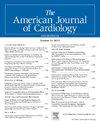Impact of Myocardial Bridging on Hemodynamics Evaluated by Coronary Angiography-Derived Fractional Flow Reserve
IF 2.1
3区 医学
Q2 CARDIAC & CARDIOVASCULAR SYSTEMS
引用次数: 0
Abstract
Myocardial bridging (MB) is a kind of congenital coronary abnormality. The functional impact of MB on coronary artery remains a subject of debate. This study aimed to assess the hemodynamic effects of MB using coronary angiography-derived fractional flow reserve (caFFR) and elucidate the relationship between MB anatomical parameters and diastolic caFFR (dcaFFR) in patients with isolated MB (iMB) and MB combined with proximal coronary atherosclerosis (MB+AS). A total of 683 patients diagnosed with MB located on left anterior descending (LAD) via coronary angiography (CAG) were retrospectively enrolled and categorized into two groups: iMB (n = 377) and MB+AS (n = 306). The dcaFFR was calculated to evaluate the hemodynamic impact of MB. Multivariate linear regression and mediation analysis were performed to identify predictors of dcaFFR. In the iMB group, diastolic minimal lumen diameter (MLD) of MB segment was the sole independent predictor of dcaFFR (B = 0.036, β = 0.253, p <0.001). In the group of MB+AS, the severity of proximal stenosis emerged as the only independent predictor of dcaFFR (B = −0.004, β = −0.674, p <0.001), with the hemodynamic effects of MB fully mediated by proximal stenosis. In conclusion, the hemodynamic impact of MB depends on the presence of proximal coronary atherosclerosis. In iMB cases, the diastolic MLD of MB segment directly determines hemodynamic impairment. However, the hemodynamic impact of MB is nonsignificant in cases of MB+AS, as its effect is fully mediated through proximal stenosis severity.
通过冠状动脉造影评估心肌桥接对血流动力学的影响。
心肌桥是一种先天性冠状动脉异常。MB对冠状动脉的功能影响仍然是一个有争议的话题。本研究旨在通过冠状动脉造影衍生的血流储备分数(caFFR)评估MB对血流动力学的影响,并阐明孤立性MB (iMB)和MB合并近端冠状动脉粥样硬化(MB+AS)患者MB解剖参数与舒张期caFFR (dcaFFR)的关系。回顾性纳入683例经冠状动脉造影(CAG)诊断为左前降层(LAD)的MB患者,并将其分为两组:iMB组( = 377)和MB+AS组( = 306)。计算dcaFFR以评估MB对血流动力学的影响。进行多元线性回归和中介分析以确定dcaFFR的预测因子。在iMB组中,MB段舒张最小管腔直径(MLD)是dcaFFR的唯一独立预测因子(B = 0.036,β = 0.253,p < 0.001)。在MB+AS组中,近端狭窄的严重程度成为dcaFFR的唯一独立预测因子(B = -0.004,β = -0.674,p < 0.001), MB的血流动力学影响完全由近端狭窄介导。总之,MB对血流动力学的影响取决于近端冠状动脉粥样硬化的存在。在iMB病例中,MB段舒张期MLD直接决定血流动力学损害。然而,MB+AS对血流动力学的影响不显著,因为其影响完全通过近端狭窄严重程度介导。
本文章由计算机程序翻译,如有差异,请以英文原文为准。
求助全文
约1分钟内获得全文
求助全文
来源期刊

American Journal of Cardiology
医学-心血管系统
CiteScore
4.00
自引率
3.60%
发文量
698
审稿时长
33 days
期刊介绍:
Published 24 times a year, The American Journal of Cardiology® is an independent journal designed for cardiovascular disease specialists and internists with a subspecialty in cardiology throughout the world. AJC is an independent, scientific, peer-reviewed journal of original articles that focus on the practical, clinical approach to the diagnosis and treatment of cardiovascular disease. AJC has one of the fastest acceptance to publication times in Cardiology. Features report on systemic hypertension, methodology, drugs, pacing, arrhythmia, preventive cardiology, congestive heart failure, valvular heart disease, congenital heart disease, and cardiomyopathy. Also included are editorials, readers'' comments, and symposia.
 求助内容:
求助内容: 应助结果提醒方式:
应助结果提醒方式:


